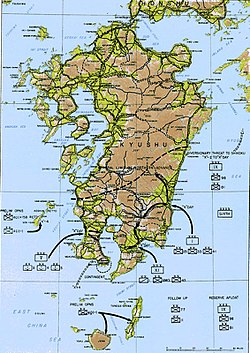
Operation Downfall was the proposed Allied plan for the invasion of the Japanese home islands near the end of World War II.
Contents
- Order of Battle for Olympic
- Allied
- Japan
- Order of Battle for Coronet
- Allied 2
- Japan 2
- Notes
- References
The operation had two parts, Operation Olympic, intended to capture the southern third of the southernmost main Japanese island, Kyūshū, and Operation Coronet, the planned invasion of the Kantō Plain, near Tokyo, on the main Japanese island of Honshu. Olympic was scheduled for November 1945, to be followed by Coronet in early 1946.
If Downfall had taken place, it would have been the largest amphibious operation in history, surpassing D-Day. [1] The planned operation was canceled when Japan surrendered following the atomic bombings of Hiroshima and Nagasaki, the Soviet declaration of war, and the invasion of Manchuria. [2]













